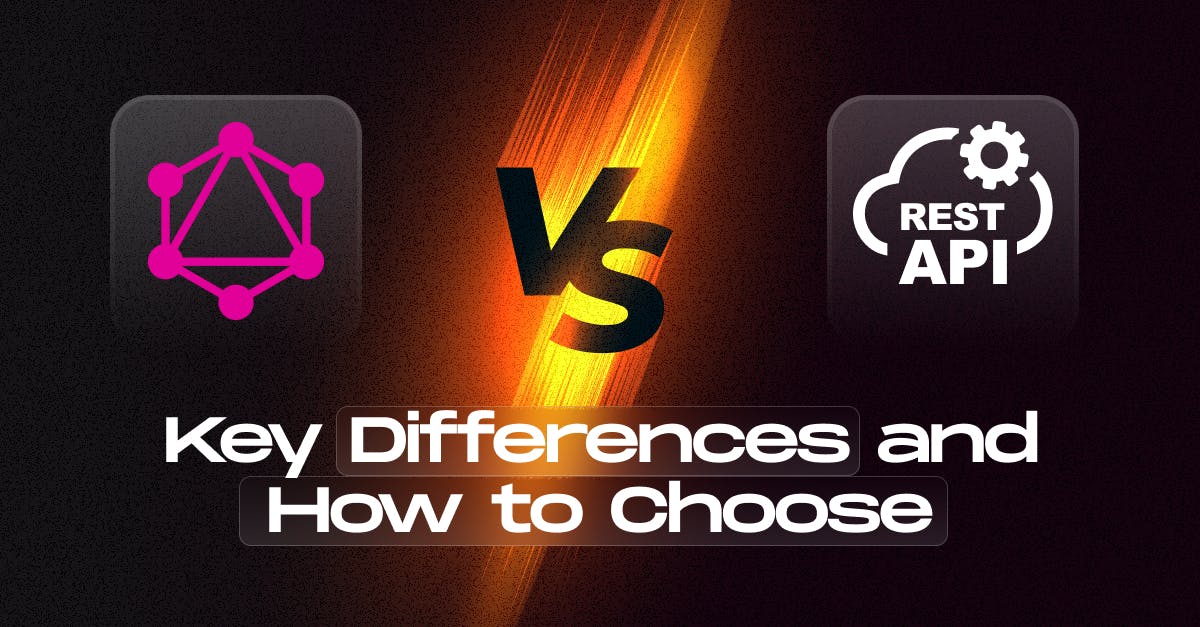May 16, 2025
GraphQL vs REST APIs: What's the Difference?

Nusrat Sarmin

In web development, choosing the right API architecture directly impacts how your application performs and scales. An API works as a middleman between the client and the server, facilitating communication and data exchange.
Two prominent contenders in this space are REST and GraphQL. While REST has long been the standard, GraphQL has emerged as a powerful alternative, offering unique advantages.
But what exactly are the key differences between GraphQL and REST?
When comparing GraphQL vs REST APIs, understanding their distinctions can help you decide which one aligns best with your project’s needs. Let’s dive in.
What Is REST?
REST (Representational State Transfer) is a widely used architecture for designing networked applications. It relies on a stateless communication protocol—usually HTTP—and treats every piece of data as a resource, accessible via specific URLs.
Developers interact with REST APIs using standard HTTP methods such as:
- GET – retrieve data
- POST – create data
- PUT – update data
- DELETE – remove data
For example:
bash
GET /users/123This request might return the details of a user with ID 123.
Due to its simplicity and reliance on existing web standards, REST has been the dominant API style for over a decade. REST is widely used, mature, and supported by most tools and modern web frameworks.
If you’re interested in learning how to create one yourself, check out our guide on how to build a REST API.
What is GraphQL?
GraphQL is a query language for APIs and a runtime for executing those queries. It was developed by Facebook in 2012 and open-sourced in 2015.
Unlike REST, which has multiple endpoints, GraphQL uses a single endpoint to handle all requests. Clients specify exactly what data they need, and the server responds with only that data—nothing more, nothing less.
A typical GraphQL query looks like this:
grapgql
{ user(id: "123") {
name
email
posts {
title
}
}
}This request asks for a user’s name, email, and the titles of their posts—all in a single call.
GraphQL vs REST: Key Differences
When choosing between GraphQL and REST for your API design, understanding their core differences is crucial. GraphQL lets clients request exactly the data they need in a single query, reducing multiple network calls and over-fetching. REST uses fixed endpoints that often require several requests for related data. While REST relies on versioned APIs, GraphQL evolves its schema without strict versioning. Though caching is simpler in REST, GraphQL benefits from advanced client-side caching tools.
1. Data Fetching
One of the major differences between REST and GraphQL lies in how they handle data retrieval.
With REST, retrieving complex or related data often requires multiple network requests to different endpoints. For example, getting a post and its related comments might require two or more API calls.
GraphQL, on the other hand, allows developers to request all necessary data in a single query. This reduces the number of round trips between the client and server, resulting in better performance and a more efficient user experience.
2. Flexibility and Efficiency
REST APIs typically return fixed data structures. Even if an application needs only a small portion of the data, the entire resource is sent in the response.GraphQL offers greater flexibility by allowing clients to specify exactly which fields they want. This minimizes the amount of data transferred over the network.
In practice, this can lead to major performance improvements. Shopify, for instance, reported that GraphQL reduced their API payload size by 94% in certain scenarios.
3. API Versioning
Versioning is a common challenge in API development. REST APIs often manage changes by introducing new versions (e.g., /v1/, /v2/), which can lead to increased maintenance and user confusion.
GraphQL handles changes differently. Instead of creating new versions, it allows the schema to evolve over time. Deprecated fields can remain in use while new ones are introduced, enabling more seamless transitions.
4. Error Handling
REST APIs typically use HTTP status codes (e.g., 200, 404, 500) to indicate the success or failure of a request. This approach is straightforward and widely understood.
GraphQL handles errors within the response body itself. Even if a query fails, the HTTP response may still return a status code of 200, with detailed error messages embedded in the response.
This can make debugging slightly more complex, especially for teams accustomed to REST’s error handling.
5. Caching and Performance
REST works well with traditional caching mechanisms such as HTTP headers, CDNs, and browser caches. Because each endpoint corresponds to a specific resource, caching is straightforward.
GraphQL queries are often unique, which makes caching more complex. However, modern tools like Apollo Client provide robust in-memory and persisted caching solutions. With the right setup, GraphQL can match—and even surpass—REST in performance.
6. Learning Curve and Tooling
REST follows standard web conventions, making it easier for developers to learn and implement quickly.
GraphQL introduces new concepts such as schemas, types, queries, and mutations. This results in a steeper learning curve. However, GraphQL’s ecosystem includes powerful tools like:
- GraphiQL (an in-browser IDE for testing queries)
- Apollo Client
- Relay
These tools enhance the development experience and help teams adopt GraphQL more easily.
When Should You Use REST?
REST is an ideal option when you need a quick, straightforward API implementation. Its simplicity, maturity, and wide adoption make it a go-to solution in many development scenarios.
REST is an excellent choice in the following cases:
- Building simple CRUD-based applications
- Working with teams that are already familiar with REST
- Needing quick and easy caching through HTTP
- Integrating with third-party APIs that use REST
Its mature ecosystem and simplicity make it suitable for a wide range of applications.
When Should You Use GraphQL?
GraphQL works best for complex, data-driven systems with flexible and evolving requirements.
GraphQL is ideal for applications that:
- Require frequent changes or updates to the API
- Support multiple client types (e.g., mobile, desktop, web)
- Need to reduce over-fetching and improve performance
- Use data from multiple sources (e.g., microservices application)
Its flexibility and efficiency make it well-suited for complex, data-driven applications.
The Bottom Line
Ultimately, the decision between GraphQL vs REST is a strategic one. Carefully evaluate your project's requirements, your team's capabilities, and the long-term goals of your application to make an informed choice. You might even find scenarios where a hybrid approach, utilizing both technologies for different parts of your application, could be the most effective solution.
Need Help Choosing Between REST and GraphQL? At StaticMania, we build fast, scalable, and modern web solutions tailored to your needs—whether you're working with REST APIs, GraphQL, or going full headless. Get in touch and let’s build something amazing together.
FAQ: GraphQL vs REST
GraphQL is a query language that allows clients to request specific data from a single endpoint. REST exposes multiple endpoints that return predefined data structures. GraphQL is flexible; REST is structured.
GraphQL can be better for dynamic applications, especially where the client needs precise control over data. However, REST is easier to cache and is better for simpler, CRUD-based APIs.
Use GraphQL when:
- You need to fetch deeply nested or related data.
- The client app requires flexibility.
- You want to minimize the number of API requests.
Yes, in many cases. GraphQL can fully replace REST for modern applications but isn't always necessary for simpler use cases. Some projects combine both.
GraphQL often reduces payload size and number of requests, making it faster in data-heavy applications. However, REST may be faster in simpler setups due to its caching capabilities.
No, neither is inherently more secure. Both require proper security measures. GraphQL needs protections against complex or malicious queries; REST needs endpoint and method protections.
Companies using GraphQL include:
- Facebook (creator of GraphQL)
- GitHub
- Shopify
- Coursera
- Airbnb
Yes, GraphQL typically transmits data in JSON format for both requests and responses.
Yes. GraphQL can act as a gateway to multiple REST APIs or work alongside them to serve different parts of an application.
REST is easier for beginners because it aligns closely with HTTP concepts. GraphQL has a steeper learning curve due to its schema definitions and query language.

